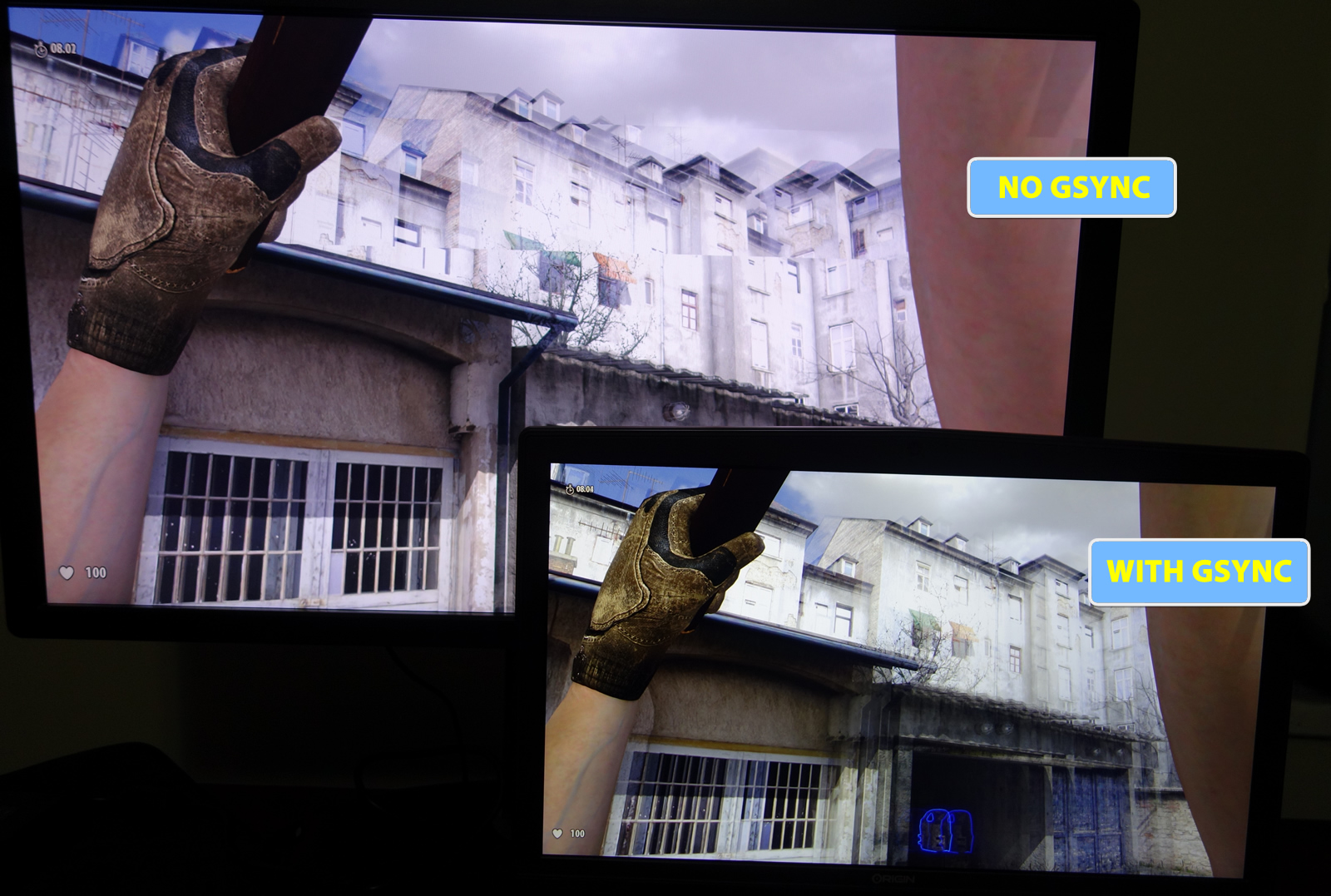Understanding Variable Refresh Rate Technology
If you've ever witnessed variable refresh rate (VRR) technologies like G-Sync and FreeSync, then you likely know VRR one of the most significant gaming improvements in recent times. G-Sync has been slowly creeping into desktop displays since 2014, but now the technology has finally gone mobile. With our tricked out Origin EON17-X gaming notebook, we'll be exploring Nvidia's Mobile G-Sync and how it translates to gaming on the go.
G-Sync is Nvidia's somewhat commonsense answer to two age-old dilemmas: screen tearing and frame stutter. It's a type of variable refresh rate technology that attempts to synchronize display refresh rates to GPU frame rates. To understand the significance of G-Sync (or VRR in general) though, one should also be familiar with screen tearing, frame stuttering and Vsync.
Screen tearing is the product of frames being rendered and displayed at differing rates. While in-game frame rates may vary a great deal during gaming sessions, a typical computer display has a scan interval of 60Hz – in other words, the screen is updated 60 times per second. The end result is some rendered frames are scanned mid-cycle so you actually see two adjacent frames displayed simultaneously with a "tear" separating them.
G-Sync wants to give gamers the best of both worlds: no tearing, no stuttering and the smoothest most even gameplay possible. Overall, G-Sync delivers.
To solve this phenomenon, Vsync has long been the (imperfect) answer. Vsync throttles frame rendering to a fixed number per second, like 30 or 60. The good news is this eliminates screen tearing because both the display and rendering frame rates are synchronized. For many games though, frame rate limiting can be perceived as a performance hit. Systems unable to maintain 60 FPS will be locked to 30, making Twitch gamers unhappy. Worse still, locking frame rates this low can create stuttering and exaggerate feelings of overall unresponsiveness. As a kind of Sophie's choice, many gamers choose to disable Vsync and live with screen tearing.
G-Sync wants to give gamers the best of both worlds: no tearing, no stuttering and the smoothest most even gameplay possible. Overall, G-Sync delivers. It does this by dynamically adjusting the display's refresh rate to match the GPU's frame rendering. G-Sync is a hardware solution that requires a compatible display and GPU (GeForce GTX 650 or newer). However, G-Sync also comes at a hefty cost – as of writing, the cheapest G-Sync capable display at Newegg was a 24 inch AOC for $370.
Mobile G-Sync works pretty much the same, but gone is the need for a factory-installed display module. Driven by industry-standard LVDS and eDP connections, notebook display panels share a unique relationship with their host GPU. Manufacturers are able to implement G-Sync with no additional hardware. For this reason, it was long speculated that G-Sync would make it to notebooks so the real question was when. Well, now it's here.
Although Nvidia's proprietary G-Sync solution was first to launch, AMD debuted its own VRR technology in March called FreeSync. AMD had long been pushing for DisplayPort to include an open VRR standard in its spec. Sure enough, VESA introduced Adaptive-Sync with DisplayPort 1.2a. AMD was now able to tap into Adaptive-Sync, avoiding the need for costly hardware modules to make FreeSync work. Unfortunately, few monitors currently command a 1.2a DisplayPort and I've yet to see a laptop advertising FreeSync for its built-in display.
Interestingly, G-Sync and FreeSync work similarly but do differ in some respects. Check out our FreeSync review for a detailed comparison. It should be said that both FreeSync and G-Sync have continued to evolve in recent months, like improving operation at lower and higher frame rates, windowed mode capabilities and multi-GPU support. With Mobile G-Sync, Nvidia seems to be positioning itself as the "quality" VRR solution by setting guidelines, like ensuring laptop manufacturers install good quality panels.
Testing out the Origin EON-17X
For purposes of trying out Mobile G-Sync, Origin kindly let us kick the tires on its EON17-X. Indeed, the results were impressive. Like the EON15-X we reviewed a couple months ago, the EON17-X is a serious gaming machine packing a full scale desktop CPU. It's essentially the same laptop, but with a 17-inch TN panel capable of G-Sync and 75Hz. Missing is the 4K panel, but that's okay – even with its mighty GTX 980M, gaming at 4K proved to be quite a challenge. 1080p is perfect for testing G-Sync.
When it comes to laptops, there are just a handful of G-Sync options. For the record, none of these laptops are thin and light. Rather, giant slabs of gaming muscle from Asus, Clevo, MSI, and of course, Origin, are being outfitted with G-Sync technology. Nvidia bluntly states that G-Sync is not compatible with Optimus, its power-saving graphics switching technology. Since the hardware component is missing for Mobile G-Sync, it relies on direct GPU-to-panel communication via eDP. Hybrid GPU designs seem to be at odds with this aspect of G-Sync. For this, it's likely G-Sync will remain relegated to beefy gaming notebooks where battery life isn't a concern.
For gamers only: Nvidia bluntly states that G-Sync is not compatible with Optimus, its power-saving graphics switching technology
To test the effectiveness of Mobile G-Sync, our Origin EON17-X was put in "Duplicate Display" mode and connected a 27-inch IPS screen. With the laptop display open and a monitor off to the side, a number of gaming sessions were performed with different games at different settings. I also did some gaming with Vsync enabled and just the laptop display by itself. In many cases, the differences were dramatic. G-Sync was plainly favored. This held particularly true for games that ran "moderately well" around 40-60 FPS. Even my wife, decidedly a non-gamer, preferred how G-Sync looked over the alternatives.
Not surprisingly, Nvidia's own pendulum demo offers a very clear picture of what G-Sync accomplishes. Watch the following video to see the difference between our G-Sync enabled EON17-X (lower right) and desktop display with no VRR (upper left).
When it's good, it's really good. However, the benefits of G-Sync become far less noticeable at frame rates lower than 30 FPS. Powered by a desktop Intel Core i7 and a GTX 980M, the EON17-X is tough to bring to its knees. However, it did dip into the 20s with Crysis 3, Sleeping Dogs and Metro Last Light with everything maxed. Mobile G-Sync didn't seem to impact performance when subjected to lower frame rates. Likewise, G-Sync performed well at very high frame rates.
Not unlike Vsync, G-Sync also caps frame rates to the display's maximum refresh rate. This is done to prevent screen tearing. Unlike Vsync though, G-Sync will continue to dynamically control refresh rate in the event it drops below the max refresh rate. This already makes it an improvement over Vsync. Even so, frame limiting can still cause stutter in fast-paced games even at 60 fps.
Nvidia attempts to address this in two ways. First, Mobile G-Sync requires display panels with a minimum refresh rate of 75Hz. This 15Hz bump helps significantly reduce perceivable stutter. Second, users can now configure G-Sync to stop frame limiting once rendering surpasses the display's maximum scan interval. Unfortunately, the latter reintroduces screen tearing, but gamers who take performance very seriously may appreciate the option. Personally, I found 75Hz quite acceptable. Once 144Hz G-Sync displays are the norm on laptops, disabling the frame rate limiter should finally become a moot practice.
G-Sync or FreeSync? I dare not answer that. But I freely admit I'm "all in" when it comes to VRR in general. Once you've experienced VRR in person, you'll never look back. It's difficult to explain, but games on a G-Sync display look like they always have in your mind. The difference is both subtle and significant. It's a blessing for PC gaming and something I believe will become standard in the years to come. Even on a 17-inch laptop screen, the effects are very noticeable and pleasant. With G-Sync, games running at 35-45 FPS no longer feel choppy. The experience is greatly improved.
The difference is both subtle and significant. It's a blessing for PC gaming and something I believe will become standard in the years to come.
Unfortunately, we can't be sure how much mobile G-Sync actually costs. Desktop displays tend to be $100-$150 more expensive than their non-G-Sync counterparts. Although notebooks get to forgo Nvidia's hardware display module, there's almost certainly a fee for implementing G-Sync as it's proprietary technology. Nvidia also works with manufacturers to control the standard. So far, any G-Sync laptop I've configured hasn't had a non-G-Sync panel option to compare prices. Judging by the starting price of Origin's $1900 EON17-X laptop though, G-Sync isn't cost prohibitive.
Should you buy a Mobile G-Sync equipped laptop? Taking nothing else into consideration, absolutely. In fact, I would pay a (reasonable) premium for it. Of course, the archetypal G-Sync laptop is currently a chunky, battery-sucking gaming machine. If you're looking for a high-end gaming desktop replacement, then there are a few solid options out there (e.g. Origin EON17-X, Gigabyte Aorus, Asus G751). However, if you're in the market for a more mainstream laptop – something with more than 2 hours of battery life and under 5 pounds – then you'll have to wait until Mobile G-Sync spreads to a wider variety of laptops.





